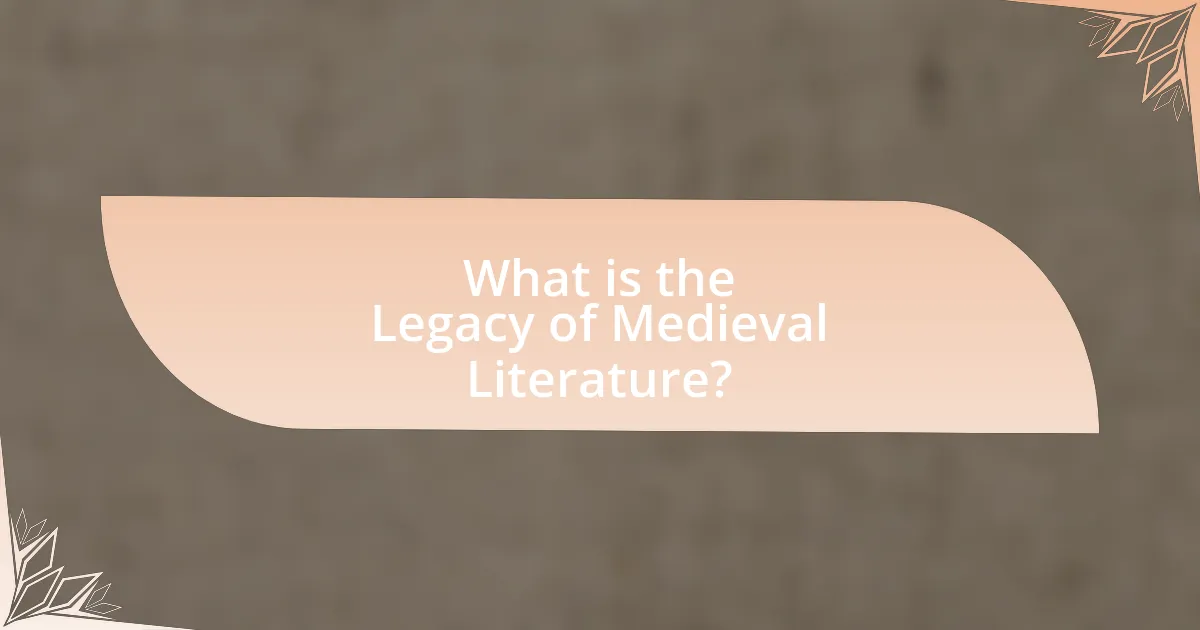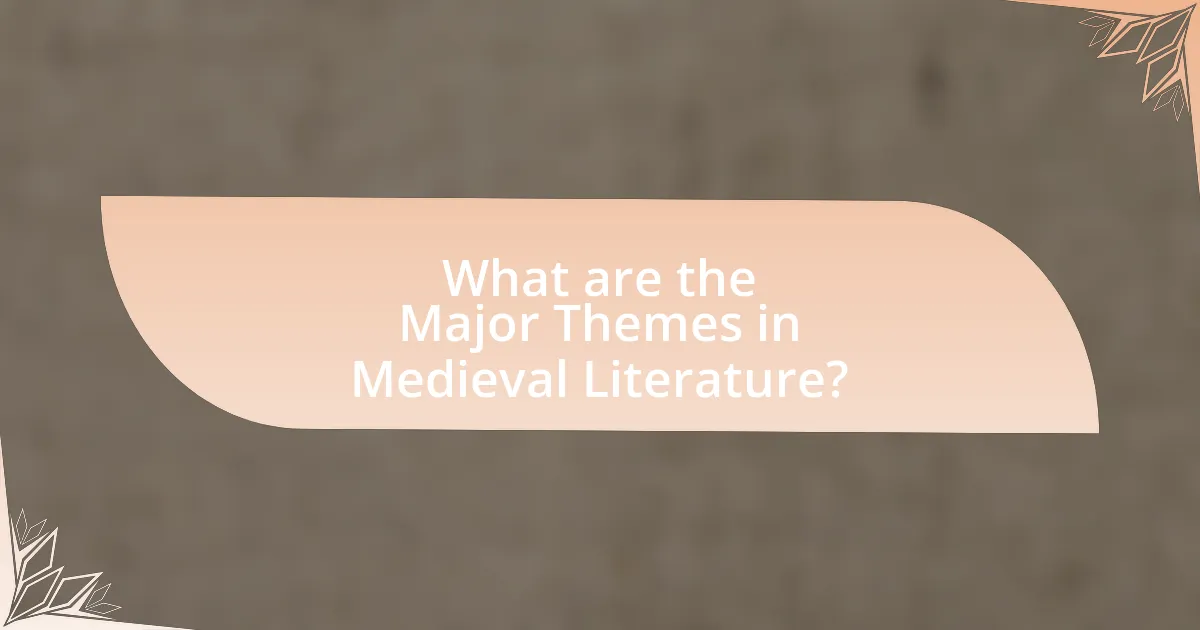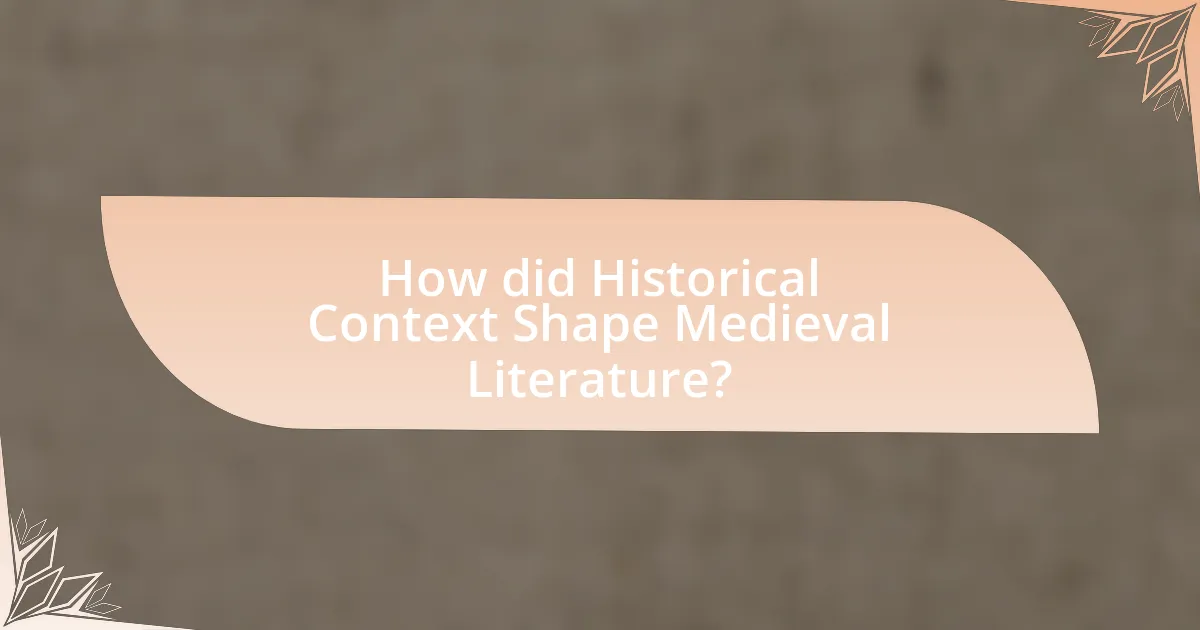The article examines the legacy of medieval literature, highlighting its significant impact on the English language, narrative forms, and cultural identity. It traces the evolution of literature from “Beowulf” to Geoffrey Chaucer’s “The Canterbury Tales,” emphasizing shifts in language, themes, and character development. Key characteristics of foundational texts, such as the exploration of heroism and morality, are discussed, along with the influence of historical context, social structures, and religious themes on literary works. The article also outlines best practices for studying medieval literature, providing insights into the complexities of the period’s literary landscape.

What is the Legacy of Medieval Literature?
The legacy of medieval literature is characterized by its profound influence on the development of the English language, narrative forms, and cultural identity. Works such as “Beowulf” and Geoffrey Chaucer’s “The Canterbury Tales” established foundational themes and storytelling techniques that shaped subsequent literature. The use of vernacular language in these texts contributed to the evolution of English, moving away from Latin dominance and making literature accessible to a broader audience. Additionally, medieval literature introduced complex characters and moral dilemmas, which paved the way for modern character development and thematic exploration in literature. The preservation and study of these texts have also provided insights into medieval society, values, and beliefs, further solidifying their importance in the literary canon.
How did Medieval Literature evolve from Beowulf to Chaucer?
Medieval literature evolved from Beowulf to Chaucer through significant shifts in language, themes, and narrative styles. Beowulf, composed in Old English, reflects a heroic tradition focused on valor, loyalty, and the supernatural, while Chaucer’s works, particularly The Canterbury Tales, are written in Middle English and showcase a diverse range of characters and social commentary. This evolution illustrates the transition from a primarily oral tradition to a more sophisticated written form, influenced by the Norman Conquest, which introduced French vocabulary and literary forms. Additionally, Chaucer’s use of satire and realism marks a departure from the idealized heroism of Beowulf, highlighting the complexities of human nature and society.
What are the key characteristics of Beowulf as a foundational text?
Beowulf is characterized as a foundational text due to its exploration of heroism, the integration of pagan and Christian elements, and its reflection of early medieval society. The poem presents the archetype of the epic hero through Beowulf’s bravery and strength in battling formidable foes like Grendel and the dragon, which underscores the values of courage and loyalty prevalent in the Anglo-Saxon culture. Additionally, Beowulf incorporates both pagan traditions, such as fate and warrior culture, and Christian themes, including the moral implications of good versus evil, illustrating the transitional nature of the period. The text also serves as a historical document, providing insights into the social structure, customs, and beliefs of early medieval England, thus solidifying its status as a cornerstone of English literature.
How did the themes in Beowulf influence later works?
The themes in Beowulf significantly influenced later works by establishing foundational concepts of heroism, morality, and the struggle between good and evil. These themes are echoed in subsequent literature, such as in the works of Geoffrey Chaucer, where the complexities of human nature and moral dilemmas are explored. Additionally, the epic’s emphasis on loyalty and honor can be seen in later medieval romances, which often depict chivalric ideals. The narrative structure and character archetypes introduced in Beowulf also laid the groundwork for the development of the epic and romance genres, influencing authors like Sir Thomas Malory in “Le Morte d’Arthur.” This continuity of themes demonstrates Beowulf’s lasting impact on the evolution of medieval literature.
Why is Chaucer considered a pivotal figure in Medieval Literature?
Chaucer is considered a pivotal figure in Medieval Literature because he is often regarded as the father of English literature and the first major poet to write in the English vernacular. His most famous work, “The Canterbury Tales,” showcases a diverse range of characters and social commentary, reflecting the complexities of 14th-century society. Chaucer’s use of iambic pentameter and narrative structure influenced subsequent English poetry and prose, establishing a foundation for future writers. His ability to blend humor, realism, and moral lessons in storytelling set a precedent for character-driven narratives in literature.
What are the main works of Chaucer and their significance?
Geoffrey Chaucer’s main works include “The Canterbury Tales,” “Troilus and Criseyde,” and “The Book of the Duchess.” “The Canterbury Tales,” a collection of stories told by pilgrims, is significant for its vivid portrayal of 14th-century English society and its use of the vernacular, which helped establish English as a literary language. “Troilus and Criseyde,” a narrative poem, is notable for its exploration of love and fate, showcasing Chaucer’s skill in character development and emotional depth. “The Book of the Duchess,” an elegy, is significant for its innovative use of dream vision and its reflection on themes of loss and mourning. These works collectively highlight Chaucer’s influence on narrative structure and character portrayal in literature.
How did Chaucer’s writing style differ from earlier Medieval authors?
Chaucer’s writing style differed from earlier Medieval authors by employing a more varied and realistic narrative voice, as well as incorporating a greater range of characters and social classes. Unlike the predominantly religious and allegorical themes of earlier works, Chaucer’s “The Canterbury Tales” features a diverse cast of characters from different backgrounds, showcasing their individual stories and perspectives. This approach reflects a shift towards realism and humanism in literature during the late 14th century, contrasting with the more didactic and moralistic tone of earlier Medieval texts such as “Beowulf” and “The Divine Comedy.” Chaucer’s use of the vernacular English language also made literature more accessible to a broader audience, further distinguishing his style from that of his predecessors who often wrote in Latin or French.

What are the Major Themes in Medieval Literature?
Major themes in medieval literature include chivalry, religion, and the human condition. Chivalry is often depicted through tales of knights and their quests, emphasizing ideals such as bravery, honor, and loyalty, as seen in works like “Sir Gawain and the Green Knight.” Religion plays a central role, with many texts exploring faith, morality, and the divine, exemplified by Dante’s “Divine Comedy,” which reflects the medieval worldview of sin and redemption. Additionally, the human condition is examined through themes of love, fate, and social hierarchy, as illustrated in Chaucer’s “The Canterbury Tales,” which presents a diverse range of characters and their experiences. These themes collectively reflect the complexities of medieval society and its values.
How do themes of heroism and morality manifest in Medieval texts?
Themes of heroism and morality manifest in Medieval texts through the portrayal of noble characters who embody virtues such as bravery, honor, and loyalty while facing moral dilemmas. For instance, in “Beowulf,” the protagonist exemplifies heroism by battling formidable foes like Grendel and his mother, driven by a sense of duty to protect his people, which reflects the moral imperative of self-sacrifice for the greater good. Similarly, in “Sir Gawain and the Green Knight,” Gawain’s journey highlights the conflict between personal honor and ethical conduct, as he grapples with the challenge of maintaining his integrity in the face of temptation. These narratives illustrate how Medieval literature often intertwines heroic deeds with moral lessons, emphasizing the importance of virtue in the pursuit of glory and the complexities of ethical decision-making in a turbulent world.
What role does the concept of the hero play in Beowulf?
The concept of the hero in Beowulf serves as a central theme that embodies the values of courage, loyalty, and honor in Anglo-Saxon culture. Beowulf, the protagonist, exemplifies these heroic traits through his battles against formidable foes such as Grendel, Grendel’s mother, and the dragon, showcasing his strength and bravery. His willingness to confront danger for the sake of others reflects the societal expectation of a hero to protect and lead. Furthermore, Beowulf’s actions and decisions highlight the importance of reputation and legacy, as he seeks to be remembered as a great warrior. This portrayal of heroism not only reinforces the cultural ideals of the time but also establishes a narrative framework that influences later literary works, making Beowulf a foundational text in the legacy of medieval literature.
How does Chaucer address morality in The Canterbury Tales?
Chaucer addresses morality in The Canterbury Tales through the diverse characters and their stories, which reflect various moral lessons and societal critiques. Each tale serves as a vehicle for exploring themes such as hypocrisy, virtue, and vice, exemplified by characters like the Pardoner, who embodies greed and corruption, contrasting with the virtuous Knight. Chaucer’s use of satire and irony highlights the moral failings of individuals within the Church and society, encouraging readers to reflect on ethical behavior. The tales collectively illustrate the complexities of human nature and the moral dilemmas faced by individuals, reinforcing the idea that morality is multifaceted and often influenced by social context.
What influence did religion have on Medieval Literature?
Religion significantly influenced Medieval Literature by shaping its themes, characters, and moral frameworks. The dominance of Christianity during the medieval period led to the incorporation of religious motifs, biblical references, and allegorical interpretations in literary works. For instance, texts like “The Divine Comedy” by Dante Alighieri and “The Canterbury Tales” by Geoffrey Chaucer reflect the moral and spiritual concerns of their time, emphasizing salvation, virtue, and the human condition in relation to divine authority. Additionally, the Church played a crucial role in the preservation and dissemination of literature, as many works were produced in monastic settings, ensuring that religious narratives and teachings were central to the literary canon of the era.
How is religious symbolism used in Beowulf?
Religious symbolism in Beowulf is utilized to illustrate the conflict between pagan beliefs and Christian values. The poem frequently contrasts the heroic ideals of the pagan warrior culture with the moral teachings of Christianity, as seen in references to God, fate, and the afterlife. For instance, Beowulf’s reliance on divine support during battles signifies the Christian belief in providence, while the frequent mentions of fate reflect the pagan understanding of destiny. Additionally, the character of Grendel is often interpreted as a representation of evil, aligning with Christian symbolism of sin and the devil. This duality highlights the transitional nature of the text, showcasing the merging of two belief systems during the medieval period.
What are the religious themes present in Chaucer’s works?
Chaucer’s works prominently feature religious themes such as the critique of church corruption, the exploration of morality, and the quest for spiritual redemption. In “The Canterbury Tales,” characters like the Pardoner and the Friar exemplify the hypocrisy within the Church, highlighting issues of greed and moral decay. Additionally, the “Parson” character represents an ideal of genuine piety and moral integrity, contrasting with the corrupt figures. Chaucer’s narratives often reflect the tension between religious ideals and human behavior, illustrating the complexities of faith and the pursuit of salvation. This thematic exploration is rooted in the socio-religious context of 14th-century England, where the Church wielded significant influence over daily life and morality.

How did Historical Context Shape Medieval Literature?
Historical context significantly shaped medieval literature by influencing themes, language, and audience engagement. The socio-political landscape, including the feudal system, the rise of Christianity, and the impact of the Norman Conquest in 1066, created a framework within which authors wrote. For instance, the emergence of courtly love and chivalric ideals in works like “Sir Gawain and the Green Knight” reflected the values of the aristocracy during this period. Additionally, the use of vernacular languages, as seen in Chaucer’s “The Canterbury Tales,” was a response to the growing literacy among the middle class and the desire for relatable narratives. This historical backdrop not only dictated the content and style of medieval literature but also shaped its accessibility and relevance to contemporary audiences.
What social and political factors influenced Medieval writers?
Medieval writers were significantly influenced by social and political factors such as the feudal system, the Church’s authority, and the rise of nationalism. The feudal system structured society into hierarchical classes, which shaped the themes and characters in literature, often reflecting the lives of nobility and peasantry. The Church wielded immense power, dictating moral values and influencing writers to incorporate religious themes, as seen in works like Dante’s “Divine Comedy.” Additionally, the emergence of nationalism during the late medieval period encouraged writers to explore themes of identity and cultural pride, evident in texts like “The Canterbury Tales” by Chaucer. These factors collectively shaped the narrative styles, themes, and purposes of medieval literature.
How did the feudal system impact the themes in Medieval Literature?
The feudal system significantly influenced the themes in Medieval Literature by establishing a hierarchical structure that shaped social relationships and moral values. This system created a clear distinction between classes, which is reflected in literary works through themes of loyalty, chivalry, and the quest for honor. For instance, in “Beowulf,” the protagonist’s actions are driven by a sense of duty to his lord and kin, illustrating the feudal loyalty expected of warriors. Similarly, in works like “The Canterbury Tales,” characters navigate their social standings, revealing the complexities of class and the moral implications of their roles within the feudal hierarchy. The prevalence of these themes across various texts underscores the pervasive impact of the feudal system on the moral and social fabric of Medieval society.
What role did the Church play in the creation of literary works?
The Church played a crucial role in the creation of literary works during the medieval period by serving as a primary patron and producer of literature. Monasteries were centers of learning where monks copied and preserved texts, including religious manuscripts and classical works, which contributed to the continuity of literary traditions. For example, the Venerable Bede, a monk, authored “Ecclesiastical History of the English People,” which is a significant historical text from this era. Additionally, the Church influenced the themes and moral frameworks of literature, as seen in works like Dante Alighieri’s “Divine Comedy,” which reflects Christian theology and ethics. Thus, the Church’s involvement in education, preservation, and thematic development was instrumental in shaping medieval literature.
How did the transition from Old English to Middle English affect literature?
The transition from Old English to Middle English significantly transformed literature by introducing a more diverse vocabulary and a shift in literary themes. This evolution was marked by the influence of Norman French and Latin, which enriched the English lexicon and allowed for greater expression of complex ideas and emotions. Notably, works such as Geoffrey Chaucer’s “The Canterbury Tales” exemplify this shift, showcasing a blend of narrative styles and a focus on character-driven storytelling that was less prevalent in Old English texts like “Beowulf.” The increased accessibility of Middle English also facilitated a broader audience for literature, allowing for the rise of vernacular writing and the democratization of literary culture.
What are the linguistic changes observed from Beowulf to Chaucer?
The linguistic changes observed from Beowulf to Chaucer include the transition from Old English to Middle English, marked by significant shifts in vocabulary, grammar, and pronunciation. Old English, as seen in Beowulf, featured a complex inflectional system with a rich array of grammatical endings, while Middle English, exemplified by Chaucer’s works, simplified these inflections and incorporated a substantial number of Norman French and Latin loanwords due to the Norman Conquest of 1066. This period also saw the gradual loss of the grammatical gender system and a move towards a more fixed word order, reflecting a shift in syntactic structure. The evolution of phonetics is evident as well, with changes in vowel pronunciation that contributed to the distinct sounds of Middle English. These linguistic developments illustrate the dynamic nature of the English language during this transformative period in literature.
How did these changes reflect societal shifts during the Medieval period?
The changes in medieval literature, such as the transition from oral traditions to written texts, reflect significant societal shifts during the Medieval period by indicating a move towards literacy and the establishment of a more structured society. This shift is evidenced by the rise of vernacular languages in literature, as seen in works like “Beowulf” and Chaucer’s “The Canterbury Tales,” which made literature accessible to a broader audience beyond the clergy and nobility. Additionally, the emergence of themes related to individualism and social mobility in these texts mirrors the evolving social dynamics, including the growth of the middle class and the decline of feudalism. These literary developments illustrate how societal changes influenced cultural expression and communication during the Medieval period.
What are the best practices for studying Medieval Literature?
The best practices for studying Medieval Literature include reading primary texts in their historical context, utilizing scholarly editions with annotations, and engaging with secondary literature for critical perspectives. Understanding the socio-political and cultural background of the medieval period enhances comprehension of themes and motifs present in works like Beowulf and Chaucer’s Canterbury Tales. Scholarly editions, such as those published by the Medieval Academy of America, provide valuable insights through footnotes and commentary, which clarify archaic language and references. Additionally, participating in discussions or study groups fosters deeper analysis and diverse interpretations, enriching the overall understanding of the literature.